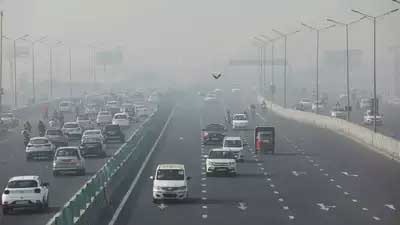After lockdown, 35% rise in nanoparticle emissions
NEW DELHI: Scientists have found that after the Covid lockdown eased in Delhi, the emission of nanoparticles, which are super-fine pollutants, increased by 35% on the city's roadside. Nanoparticles are fine pollutants which are about 1/1000th of particulate matter. They cannot be filtered out by N-95 masks.
Scientists in the department of environmental engineering at Delhi Technological University (DTU) and the space and atmospheric sciences division of the Physical Research Laboratory in Ahmedabad did a study on the roadside nanoparticles in Delhi and their impact on health and air quality. The study, called "Roadside Measurements of Nanoparticles and their Dynamics in Relation to Traffic Sources in Delhi: Impact of Restrictions and Pollution Events", found that after the lockdown, the nanoparticles had increased.
 The researchers led by Dr Rajeev Kumar Mishra, faculty in the department of environmental engineering in DTU, professor S Ramachandran of the Physical Research Laboratory, and Kanagaraj Rajagopal, a research scholar in the advance air and acoustics research laboratory in DTU, identified the concentration of the nanoparticles present on the roadside.
The researchers led by Dr Rajeev Kumar Mishra, faculty in the department of environmental engineering in DTU, professor S Ramachandran of the Physical Research Laboratory, and Kanagaraj Rajagopal, a research scholar in the advance air and acoustics research laboratory in DTU, identified the concentration of the nanoparticles present on the roadside.
The study includes a series of events in 2021, such as the lockdown, pollution events, Diwali and the time period before and after these events. It aims to identify the reduction of nano pollutants based on the emission sources. In Delhi, 10,000 to 10,00,000 nanoparticles are found in a cubic centimetre of air. During the lockdown period, when vehicles on the road were reduced to around 50%, the nanoparticle concentration was reduced by 31 %. At the same time, events such as Diwali increased nanoparticle concentration up to 35 %, compared to usual emissions," Mishra said, adding that the nanoparticles in the range of 10 to 100-nm size were directly from vehicle engine exhaust that were released on the roadside.
The study said that when windspeed is high, the nano pollutants got dispersed to surrounding regions, increasing exposure among residents living near the road.
"For a city like Delhi, residential zones adjacent to the road will automatically mean higher exposure for residents. The nanoparticles are more vulnerable in terms of human health because they are much smaller than PM2.5 or PM10," the study pointed out. These nanoparticles are 600 times smaller than the thickness of human hair and can penetrate deep into the lungs and blood stream.
"These nanoparticles have the potential to penetrate our bloodstream and can be deposited in different parts of the human body, including the brain.... People working or living near the road, such as police personnel, street vendors, drivers, motorcyclists, delivery personnel and the urban poor living near the road are more exposed to them," Mishra said. The study also suggests that policy formulation towards the concentration of the particles was required for reducing their emission from engine sources to mitigate the impact these particles have on the atmosphere and human health.
Source: The Times of India











































